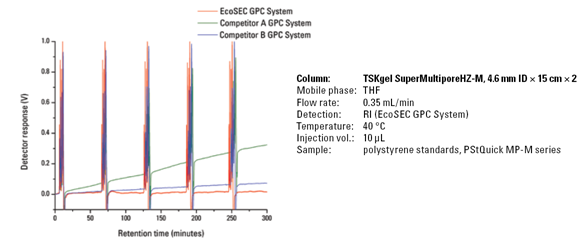The EcoSEC® GPC System offers unmatched baseline stability because it is the only GPC system which uses a dual flow refractive index detector and temperature controlled pumps. Baseline stability is essential for the accurate calculation of polymer molar mass averages. For example, computer simulations predict a polymer with a polydispersity index (PDI) of 5 will have an 18% error for Mz if baseline instability leads to a 4% error in peak width determination. In addition, a 2% uncertainty in baseline height will result in a 20% error in Mz.1
A study was done to demonstrate the superb baseline stability of the EcoSEC® GPC System compared to that of two conventional GPC systems using both 15 cm and 30 cm columns over a five hour time period. The figures below demonstrate that the EcoSEC® GPC System maintains the efficiency of semi-micro columns and maintains a stable RI baseline when both conventional and semi-micro GPC columns are used.
As shown in Figures 1A and 1B, five consecutive injections of polystyrene standards with run timesdeliberately extended to one hour without auto zeroing the detectors between injections, resulted in an extremely stable baseline with low baseline drift on the EcoSEC® GPC System and a significantly driftingbaseline on the two conventional GPC systems. In comparison to the conventional GPC systems, the EcoSEC® GPC System has both a lower baseline drift and a better signal to noise ratio.
Figure 1A. Comparison of Baseline Drift of the Dual Flow Refractive Index Detector of the EcoSEC® GPC System and Two Conventional GPC Systems using Semi-Micro Columns

Figure 1B. Comparison of Baseline Drift of the Dual Flow Refractive Index Detector of the EcoSEC® GPC System and
Two Conventional GPC Systems using Conventional Columns
1Tcjir, W.J.; Rudin, A.; and Fyfe, C.A.; Journal of Polymer Science: Polymer Physics Edition, Volume 20, Issue 8, 1443-1451.
Baseline Stability in Various Solvents